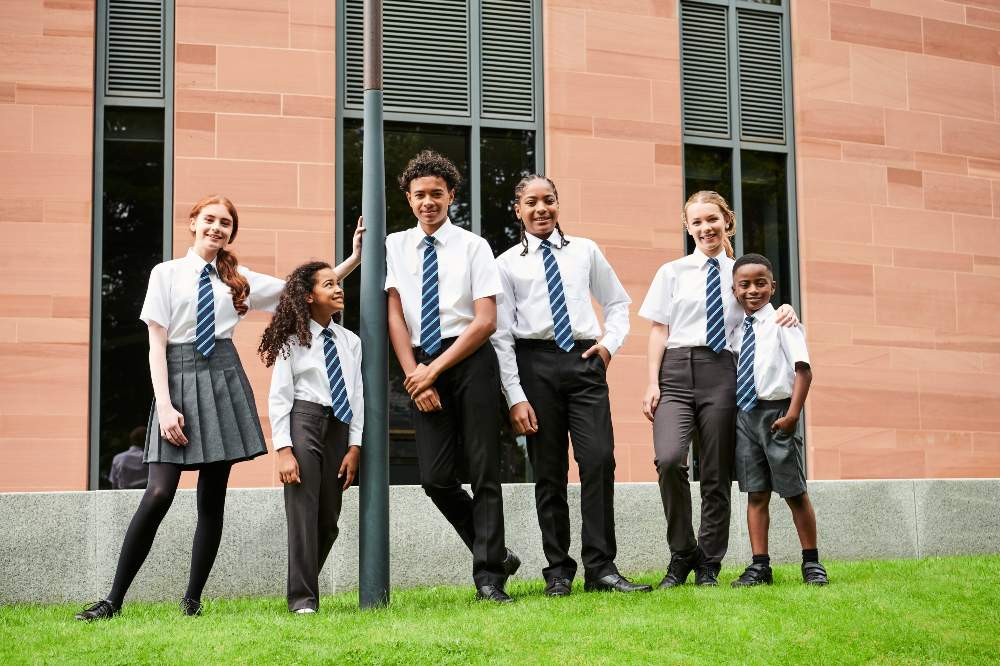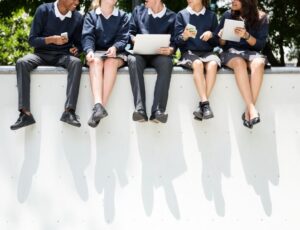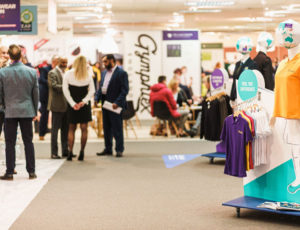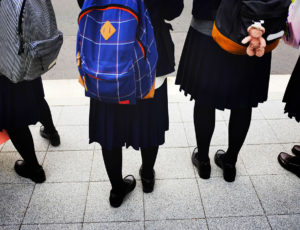
Schoolwear Association Chair Matthew Easter and Vice Chair Marie Bradburn discuss key industry issues, including the new government’s proposal to cap branded school uniform items and the Association’s counter-response.
Laura Turner: How is the Schoolwear Association (SA) responding to Labour’s pledge to limit the number of branded items of school uniform and PE kit?
Matthew Easter: We are working on several fronts, including engaging with MPs across the House of Commons, the House of Lords, the Department for Education (DfE), and of course, with school leaders and relevant associations.
Our key focus when talking to these various stakeholders is to educate them on the tangible support for and benefits of a school-specific uniform in an education setting, and to highlight the real costs as opposed to the often sensationalist media claims. We can see from our annual industry data that the Statutory Bill introduced for Back to School has had a definite impact on the cost of uniform and the number of school-specific items that schools are specifying, resulting in a 25% cost decrease in real terms over the last four years. We have gathered a lot of relevant data, both ourselves and through independent research, to reinforce the above and emphasise the negative consequences of downgrading uniform, which we strongly feel would be detrimental and likely cost parents significantly more in the long run. Of course, we are also highlighting to the Government the potentially devastating economic impact that such a limit would have on specialist retailers up and down the country, with many already warning of potential job cuts and even business closures. Although the exact details of Labour’s proposals have yet to be published, it is absolutely clear that any limit in the number of school-specific uniform items will potentially have a devastating effect on our industry.
From our annual survey data, we know that secondary schools currently specify an average of 5.2 day uniform and sportswear items, so it’s not hard to see that if a limit lower than this were to be imposed it will have huge implications, particularly bearing in mind that we’ve already seen a 25% real-term reduction in uniform costs over the past four years. Many retailers are family-owned businesses that have been an important part of local communities for generations. A cap on school uniform items, and the subsequent impact on profit margins, could push many towards closure.
From a parent and pupil perspective, we know from our research that imposing an arbitrary limit on the number of school-specific items will have a detrimental effect. School leaders are overwhelmingly in favour of school-specific uniform and set policies responsibly on a local basis, taking many factors into account. They know that school-specific uniform is good value and brings several tangible benefits to pupils. On the other hand, an arbitrary limit will result in more peer pressure, less structure, and lower quality garments that need replacing much more frequently, resulting in higher costs for parents in the long run.
LT: Do you feel the existing guidance is working?
ME: Yes, from the point of view of what the DfE intended, as we can see the average number of school-specific garments that schools have has decreased by 6% in the last two years and, as mentioned earlier, the cost of school-specific garments has decreased significantly for parents in real terms. Whilst this isn’t necessarily positive for sales in our industry, it has made schools review their uniform policy and make any adjustments they felt they should. To this end, we see a further change in the guidance as proposed as both unnecessary and detrimental.
LT: What feedback have you had from retailers?
Marie Bradburn: Reaction from retailers has been mixed. Some are very concerned and have already requested and had meetings with their local MPs to put across their concerns regarding school uniform and the impact of any changes to current legislation, explain what their businesses provide within their local communities, and not least their concerns about the future of their businesses if the uniform cap is at three.
LT: What reaction have you seen from schools?
MB: Retailers have had statements from their schools in support of their uniform in its current state, as they have already reviewed their uniform policies when the new legislation was implemented in 2022. There are many reasons why schools choose a particular uniform or garment for their pupils, they understand the demographic of their students and control should remain with each school.
LT: What are some the of key findings from the SA’s research?
ME: We have conducted several pieces of research this year, including our own annual industry cost survey. We surveyed approximately 10% of secondary schools representing c. 350,000 pupils in April 2024 and found the average basket cost of secondary school-specific day uniform and sportswear has gone down 4% to £96.24, despite significant inflationary pressures. Costs have gone down 25% in real terms in the last four years, which is remarkable when you consider how much more expensive every other aspect of life has become over the same period.
We also commissioned an independent survey of school leaders to better gauge their views and found overwhelming support for school-specific uniform with the following key findings: 88% of headteachers say school-specific uniforms reduce visible inequalities between pupils; 78% believe that school-specific uniforms improve academic performance and behaviour; 67% report a link between a defined uniform policy and improved school performance; and over one-third of headteachers have observed an increase in absenteeism on non-school uniform days. Finally, we have recently surveyed our members to understand their views on Labour’s proposals and received stark feedback about the impacts that an arbitrary cap would have on our industry.
LT: The SA will once again have a key presence at this year’s Schoolwear Show, including heading up the seminar programme. What will you be covering?
MB: The Schoolwear Show has very generously supported the seminars over the two days, giving valuable support to the schoolwear industry. On Sunday 6 October at 11am, Dan Honour from energy expert Red Hawk – which has already been used and endorsed by some of our retailers – will present ‘Managing your Energy Portfolio’ to help businesses reduce their energy bills. At 4pm on Sunday, we will see the return of the very successful Q&A Session. This has proved to be a popular event with retailers, allowing them to share their issues and concerns with other like-minded retailers and suppliers. Beer and prosecco will also be on offer for those who wish to partake. On Monday 7 October at 11am, Marc Woolfson from WA Comms will update SA members and potential new members on the situation regarding school uniform at Westminster and the progress of ‘The Children’s Well Being Bill’ and its implications to the industry, which will be followed by a Q&A. Matthew and I will also host a general SA update at 2pm.
LT: Is the SA supporting the Fashion & Textile Children’s Trust’s campaign to fund more Back to School grants?
ME: Yes, absolutely, and more broadly, many of our retail members do excellent work in providing support towards uniform costs for parents that are in most need in conjunction with the schools they supply. This altruistic service is often overlooked but is another important example of the valuable place that specialist schoolwear retailers have in the local communities up and down the UK.
LT: Are you still petitioning to make school uniform VAT-exempt?
MB: We are still calling on the Government to find alternative methods of supporting families, such as removing VAT on school uniforms. We are firmly of the belief that this VAT represents, in effect, a ‘school uniform tax.’ Scrapping it would be the most effective way to save families money while retaining the positive benefits of school uniform for children up and down the country.
LT: Beyond membership, how else can the industry support the SA’s work?
MB: It is vital that our members engage with their local MPs. There was a record 335 new MPs inducted into the House of Commons, many for the first time when Labour was elected to government. It is important to get our key messages to the people who can influence the debate of ‘The Children’s Well Being Bill,’ which was part of the King’s Speech and referenced a limit to the number of branded items of school uniform. We are all very well aware of the unintended consequences of this limit, but it is so important that we continue to educate those who maybe aren’t.
LT: What is the SA’s strategy for the coming year?
ME: We will continue working tirelessly to make sure our industry is best represented across UK governments and do our utmost to ensure that there is a sensible outcome to the current government proposals on school uniform that does not result in a worse outcome for schools, parents, pupils or ourselves.
For further information on the Schoolwear Association, please click here.











